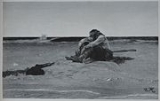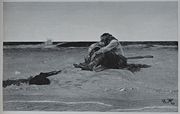
Marooning
Encyclopedia

Maroon (people)
Maroons were runaway slaves in the West Indies, Central America, South America, and North America, who formed independent settlements together...
, a word for a fugitive slave, which could be a corruption of Spanish
Spanish language
Spanish , also known as Castilian , is a Romance language in the Ibero-Romance group that evolved from several languages and dialects in central-northern Iberia around the 9th century and gradually spread with the expansion of the Kingdom of Castile into central and southern Iberia during the...
cimarrón, meaning a household animal (or slave) who has run "wild".
The practice was a penalty for crewmen, or for captains at the hands of a crew. Generally, a marooned man was set on a deserted island, often no more than a sand bar
Shoal
Shoal, shoals or shoaling may mean:* Shoal, a sandbank or reef creating shallow water, especially where it forms a hazard to shipping* Shoal draught , of a boat with shallow draught which can pass over some shoals: see Draft...
at low tide
Tide
Tides are the rise and fall of sea levels caused by the combined effects of the gravitational forces exerted by the moon and the sun and the rotation of the Earth....
. He would be given some food, a container of water, and a loaded pistol so he could commit suicide
Suicide
Suicide is the act of intentionally causing one's own death. Suicide is often committed out of despair or attributed to some underlying mental disorder, such as depression, bipolar disorder, schizophrenia, alcoholism, or drug abuse...
if he desired. The outcome of marooning was usually fatal, but William Greenaway and some men loyal to him survived being marooned, as did pirate captain Edward England
Edward England
Edward England, born Edward Seegar in Ireland, was a famous African coast and Indian Ocean pirate captain from 1717 to 1720. The ships he sailed on included the Pearl and later the Fancy, for which England exchanged the Pearl in 1720...
.
The chief practitioners of marooning were 17th and 18th century pirates
Piracy
Piracy is an act of robbery or criminal violence at sea. The term can include acts committed on land, in the air, or in other major bodies of water or on a shore. It does not normally include crimes committed against persons traveling on the same vessel as the perpetrator...
, to such a degree that they were frequently referred to as "marooners." The pirate articles of captains Bartholomew Roberts
Bartholomew Roberts
Bartholomew Roberts , born John Roberts, was a Welsh pirate who raided ships off America and West Africa between 1719 and 1722. He was the most successful pirate of the Golden Age of Piracy. He is estimated to have captured over 470 vessels...
and John Phillips
John Phillips (pirate)
John Phillips was an English pirate captain. He started his piratical career in 1721 under Thomas Anstis, and stole his own pirate vessel in 1723. He died in a surprise attack by his own prisoners...
specify marooning as a punishment for cheating one's fellow pirates or other offenses. In this context, to be marooned is euphemistically to be "made governor of an island".
During the late 18th century in the American South, "marooning" took on a humorous additional meaning describing an extended camping-out picnic over a period of several days (Oxford English Dictionary).
The most famous literary reference to marooning probably occurs in Robert Louis Stevenson
Robert Louis Stevenson
Robert Louis Balfour Stevenson was a Scottish novelist, poet, essayist and travel writer. His best-known books include Treasure Island, Kidnapped, and Strange Case of Dr Jekyll and Mr Hyde....
's Treasure Island
Treasure Island
Treasure Island is an adventure novel by Scottish author Robert Louis Stevenson, narrating a tale of "pirates and buried gold". First published as a book on May 23, 1883, it was originally serialized in the children's magazine Young Folks between 1881–82 under the title Treasure Island; or, the...
.
Another famous marooning, only partly for punishment, was leaving the sailor Alexander Selkirk
Alexander Selkirk
Alexander Selkirk was a Scottish sailor who spent four years as a castaway when he was marooned on an uninhabited island. It is probable that his travels provided the inspiration for Daniel Defoe's novel Robinson Crusoe....
on Juan Fernández Island
Robinson Crusoe Island
Robinson Crusoe Island , formerly known as Más a Tierra , or Aguas Buenas, is the largest island of the Chilean Juan Fernández archipelago, situated 674 kilometres west of South America in the South Pacific Ocean...
off the coast of Chile
Chile
Chile ,officially the Republic of Chile , is a country in South America occupying a long, narrow coastal strip between the Andes mountains to the east and the Pacific Ocean to the west. It borders Peru to the north, Bolivia to the northeast, Argentina to the east, and the Drake Passage in the far...
, in the Pacific Ocean. Selkirk, a sailor with the Dampier
William Dampier
William Dampier was an English buccaneer, sea captain, author and scientific observer...
expedition, was worried about the unseaworthy condition of his ship, the Cinque Ports
Cinque Ports (1703 ship)
Cinque Ports is the name of an English galley whose sailing master was Alexander Selkirk, generally accepted as the model for the fictional Robinson Crusoe...
, and had argued with the captain until he left him ashore on the island where they had briefly stopped for water and food supplies. The Cinque Ports later sank with the loss of most of her crew. Selkirk was not rescued until four years later, by Woodes Rogers
Woodes Rogers
Woodes Rogers was an English sea captain, privateer, and, later, the first Royal Governor of the Bahamas. He is known as the captain of the vessel that rescued the marooned Alexander Selkirk, whose plight is generally believed to have inspired Daniel Defoe's Robinson Crusoe.Rogers came from an...
. Selkirk's travails provided the inspiration for Daniel Defoe
Daniel Defoe
Daniel Defoe , born Daniel Foe, was an English trader, writer, journalist, and pamphleteer, who gained fame for his novel Robinson Crusoe. Defoe is notable for being one of the earliest proponents of the novel, as he helped to popularise the form in Britain and along with others such as Richardson,...
's novel Robinson Crusoe
Robinson Crusoe
Robinson Crusoe is a novel by Daniel Defoe that was first published in 1719. Epistolary, confessional, and didactic in form, the book is a fictional autobiography of the title character—a castaway who spends 28 years on a remote tropical island near Trinidad, encountering cannibals, captives, and...
. Today, one of the islands on the Chilean coast is named Alejandro Selkirk Island
Alejandro Selkirk Island
Alejandro Selkirk Island, previously known as Isla Más Afuera and renamed after Alexander Selkirk, is the second largest and most westernly island of the Juan Fernández Islands archipelago of the Valparaíso Region of Chile...
and another one Robinson Crusoe Island
Robinson Crusoe Island
Robinson Crusoe Island , formerly known as Más a Tierra , or Aguas Buenas, is the largest island of the Chilean Juan Fernández archipelago, situated 674 kilometres west of South America in the South Pacific Ocean...
.

